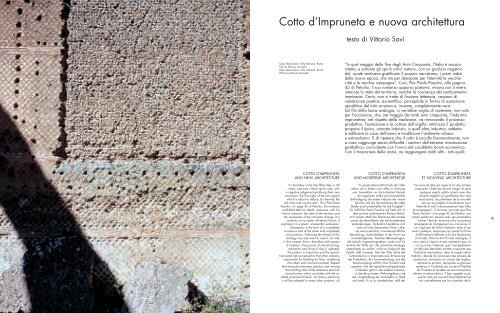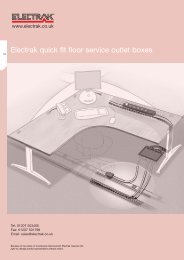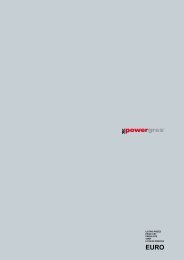by Stone & Sannini - EKA Group
by Stone & Sannini - EKA Group
by Stone & Sannini - EKA Group
You also want an ePaper? Increase the reach of your titles
YUMPU automatically turns print PDFs into web optimized ePapers that Google loves.
Cotto d’Impruneta e nuova architettura<br />
Opus Reticulatum, Villa Adriana, Roma.<br />
Foto di Alfonso Acocella.<br />
Opus Reticulatum, Villa Adriana, Rome.<br />
Photo <strong>by</strong> Alfonso Acocella.<br />
COTTO D’IMPRUNETA<br />
AND NEW ARCHITECTURE<br />
“In that May in the late fifties Italy is still<br />
intact, and only critical spirits note, with<br />
a negative judgement gratifying their own<br />
narcissism, the first signs of the new epoch<br />
which is about to deface, for eternity, the<br />
old cities and countryside”. Thus Pier Paolo<br />
Pasolini, on page 42 of Petrolio, the romance<br />
published after his death, measures, with his<br />
interior measure, the state of the territory and<br />
the awareness of the imminent change. It is<br />
certainly not a matter of literary fiction; if<br />
anything it is a poetic, unscientific evaluation,<br />
perception in the form of a completely<br />
erroneous and at the same time completely<br />
true assertion. Following the thread of this<br />
analogy one may want to assert, not only<br />
in this context, that in that May with respect<br />
to tradition, the process of manufacturing,<br />
extraction and firing of clay is updated;<br />
the product is improved, and the typical,<br />
honoured cotto proposed to that other industry,<br />
responsible for building for Man, modifying<br />
the urban and rural environment. Repeat<br />
that terracotta becomes popular, also among<br />
the building sites of the extensive post-war<br />
reconstruction which coincides with the socalled<br />
economical boom. As history advances<br />
it will be adopted in many other projects - all<br />
testo di Vittorio Savi<br />
“In quel maggio della fine degli Anni Cinquanta, l’Italia è ancora<br />
intatta, e soltanto gli spiriti critici notano, con un giudizio negativo<br />
dal quale sentivano gratificato il proprio narcisismo, i primi indizi<br />
della nuova epoca, che sta per deturpare per l’eternità le vecchie<br />
città e le vecchie campagne”. Così, Pier Paolo Pasolini, alla pagina<br />
42 di Petrolio, il suo romanzo apparso postumo, misura con il metro<br />
interiore lo stato del territorio, nonché la coscienza del cambiamento<br />
imminente. Certo, non si tratta di finzione letteraria, casomai di<br />
valutazione poetica, ascientifica, percepibile in forma di asserzione<br />
apodittica del tutto erronea e, insieme, completamente vera.<br />
Sul filo della lasca analogia, ci verrebbe voglia di sostenere, non solo<br />
per l’occasione, che, nel maggio dei tardi anni cinquanta, l’industria<br />
imprunetina, nel rispetto della tradizione, va rinnovando il processo<br />
produttivo, l’estrazione e la cottura dell’argilla; ottimizza il prodotto;<br />
propone il tipico, onorato laterizio, a quell’altra industria, addetta<br />
a edificare la casa dell’uomo e modificare l’ambiente urbano<br />
e extraurbano. E di ripetere che il cotto è accolto favorevolmente, non<br />
a caso raggiunge senza difficoltà i cantieri dell’estrema ricostruzione<br />
postbellica, coincidente con l’avvio del cosiddetto boom economico.<br />
Con il trascorrere della storia, ne raggiungerà molti altri - tutti quelli<br />
COTTO D’IMPRUNETA<br />
UND MODERNE ARCHITEKTUR<br />
“In jenem Monat Mai Ende der 50er<br />
Jahre, als in Italien noch alles in Ordnung<br />
war, bemerkten nur die kritischen Geister<br />
mit negativem Urteil und narzistischer<br />
Befriedigung die ersten Indizien der neuen<br />
Epoche und die Verunstaltung der alten<br />
Städte und Landschaften für die Ewigkeit.“<br />
So mißt Pier Paolo Pasolini auf Seite 42, in<br />
dem postum erschienenen Roman Petruli,<br />
mit innerem Maß die Stimmung des Landes<br />
sowie das Bewußtsein der bevorstehenden<br />
Veränderungen. Sicherlich handelt es sich<br />
nicht um eine literarische Fiktion, eher<br />
um eine poetische, unwissenschaftliche<br />
Beurteilung, wahrnehmbar in der Form von<br />
unwiderlegbaren, falschen Behauptungen,<br />
die jedoch insgesamt gesehen, wahr sind. Es<br />
kommt der Wille auf, die schwache Analogie<br />
unterstützen zu wollen, nicht nur aufgrund des<br />
Zufalls, daß in jenem Mai der 50er Jahre die<br />
Cottoindustrie in Impruneta eine Erneuerung<br />
der Produktion, der Tonverarbeitung und des<br />
Brennvorgangs erfährt. Das Produkt wird<br />
optimiert und der typische hochgeschätzte<br />
Cottostein geht in die andere Industrie,<br />
in die des privaten Wohnungsbaus und<br />
der Umgestaltung der Architektur in Stadt<br />
und Land. Es ist zu wiederholen, daß der<br />
COTTO D’IMPRUNETA<br />
ET NOUVELLE ARCHITECTURE<br />
“Ce mois de Mai qui signe la fin des années<br />
cinquante, l’Italie est encore vierge, et seuls<br />
quelques esprits subtils notent, avec des<br />
accents négatifs qui gratifiaient leur seul<br />
narcissisme, les prémisses de la nouvelle<br />
ère qui se prépare à bouleverser pour<br />
l’éternité le vieil ordonnancement des villes<br />
et campagnes”. C’est avec ces mots que Pier<br />
Paolo Pasolini, à la page 42 de Petrolio, son<br />
roman posthume, mesure avec ses paramètres<br />
intimes l’état du territoire et la conscience<br />
émergente du changement qui s’annonce. Il<br />
ne s’agit pas de fiction littéraire, mais d’une<br />
vision poétique, empirique qui prend la forme<br />
d’affirmations éthérées à la fois fantaisistes<br />
et lucides. Dans le droit fil des analogies, il<br />
nous vient à l’esprit, et pas seulement pour le<br />
cas qui nous intéresse, que c’est également<br />
en Mai des dernières années cinquante que<br />
l’industrie imprunetina, dans le respect de la<br />
tradition, décide du renouveau des process de<br />
production, extraction et cuisson des argiles;<br />
optimise le produit; repropose ce glorieux<br />
matériau à l’industrie qui construit l’habitat<br />
de l’homme et modèle ses environnements<br />
urbains et extra-urbains. Il faut rappeler aussi<br />
que le cotto est accueilli favorablement et<br />
tout naturellement par les chantiers de la<br />
9





